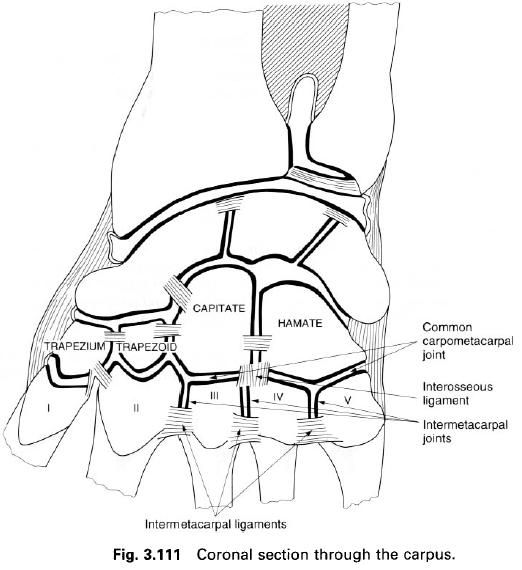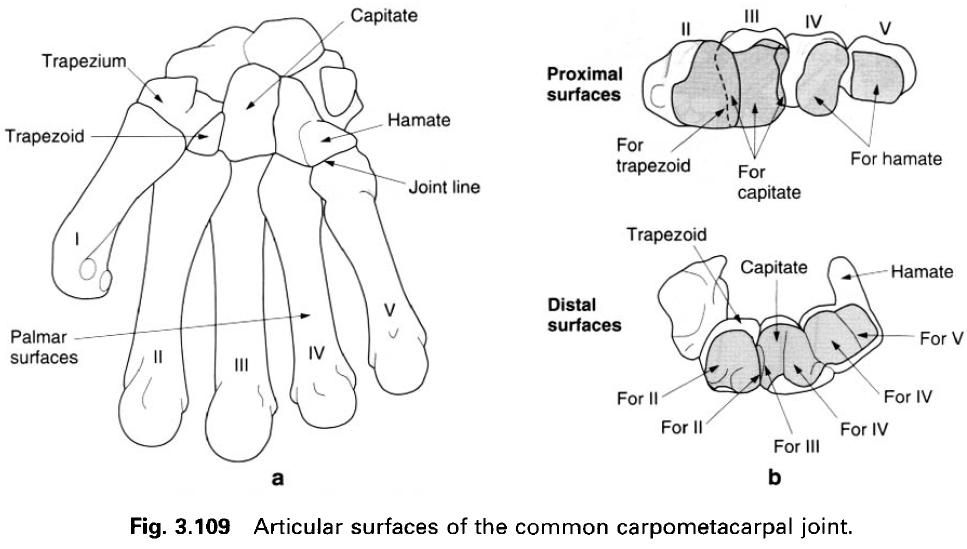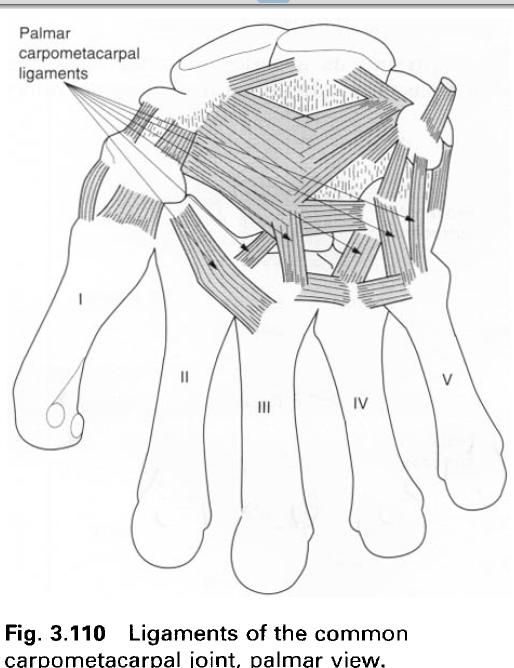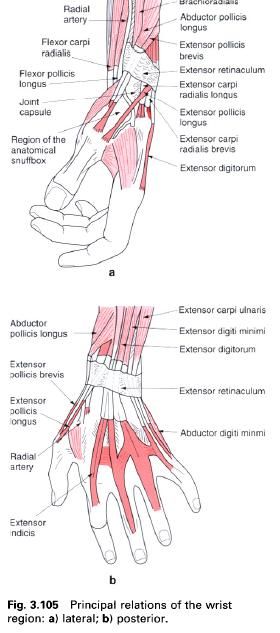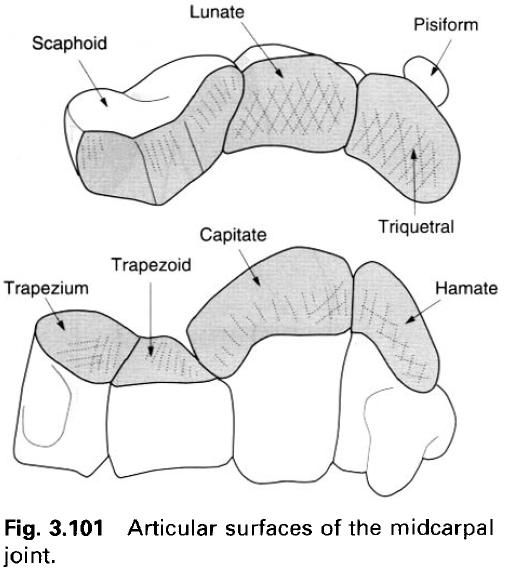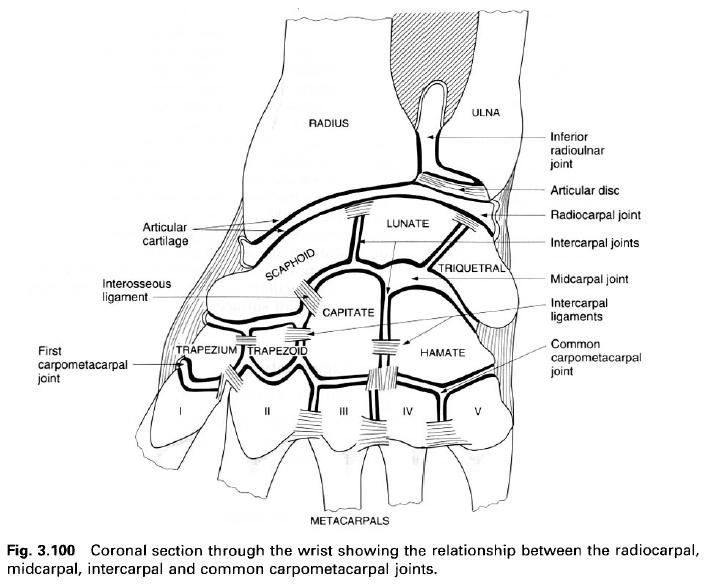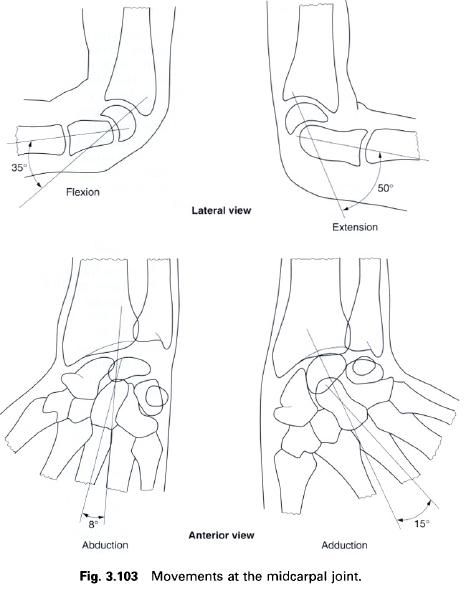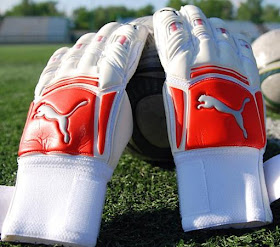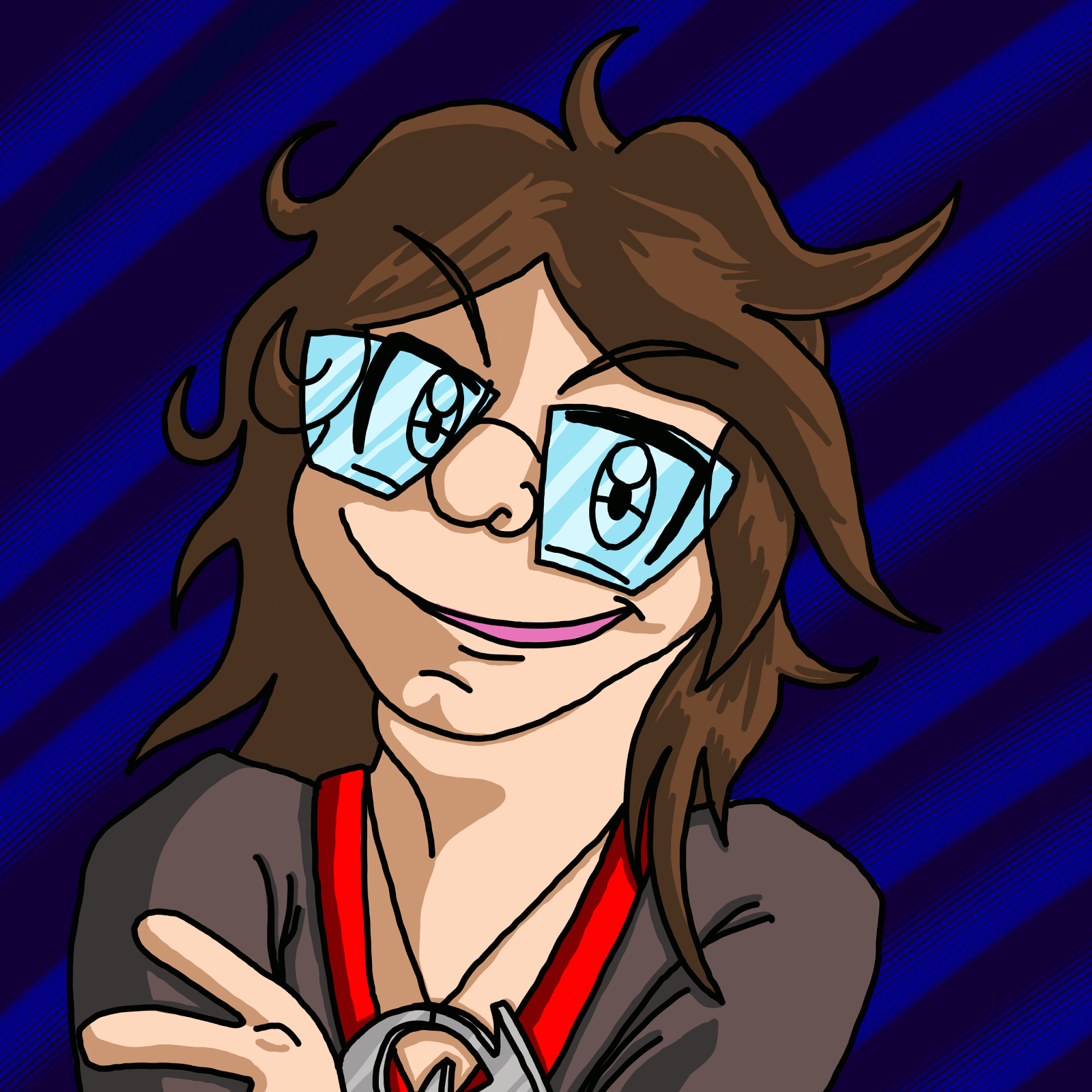The intermetacarpal joints are plane synovial
joints between the adjacent sides of the bones of the second and third, third
and fourth, and fourth and fifth metacarpals. The joints are closed anteriorly,
posteriorly and distally by palmar and dorsal metacarpal ligaments, and
interosseus ligaments respectively, that pass transversely between the adjacent
bones. Their joint spaces are continuous
with the common carpometacarpal joint distally. The blood and nerve supply to
these joints is similar to that for the common carpometacarpal joint. Movements
at these joints will accompany movements of the metacarpals against the distal
row of carpal bones. In accessory movements, a small amount of anteroposterior
gliding can be produced between any two metacarpal bases by appropriately
applied pressure.
24. 1. 2013.
The intermetacarpal joints
Ознаке:
Anatomy
The common carpometacarpal joint
The carpometacarpal joints are the sites of
articulation between the carpal and metacarpal bones. The bases of the medial
four metacarpals form, with the distal row of carpal bones, a common
carpometacarpal joint, which has an irregular joint line. The joints are, on
the whole, plane synovial joints, the only exception being the slightly beveled
joint surfaces between the hamate and the base of the fifth metacarpal.
Articular surfaces
The base of the second metacarpal fits into a
recess formed by the medial side of the trapezium, the distal surface of the
trapezoid and the anterolateral corner of the capitate. The third metacarpal
base articulates only with the distal surface of the capitate. The base of the
fourth metacarpal articulates mainly with the anterolateral distal surface of
the hamate, but also just catches the anteromedial corner of the capitate.
Finally, the base of the fifth metacarpal abuts against the anteromedial part
of the distal surface of the hamate.
Joint capsule and synovial membrane
A fibrous capsule surrounds the common joint,
in which various capsular thickenings can be identified. Synovial membrane
lines the capsule and all non-articular surfaces, attaching to the articular
margins. The joint cavity extends proximally between the carpal bones, and
usually communicates with the midcarpal joint. Distally the joint space extends
between the bones of the medial four metacarpals.
Ligaments
The dorsal and palmar carpometacarpal ligaments
are really just thickenings of the joint capsule.
Dorsal
carpometacarpal ligaments
These present as a series of bands of fibres
which pass from the distal row of carpal bones to the bases of the metacarpals.
In general, each metacarpal receives two bands. Those to the second metacarpal
come from the trapezium and trapezoid; those to the third from the trapezoid
and capitate, and those to the fourth from the capitate and hamate. The base of
the fifth metacarpal receives only a single band arising from the hamate.
Palmar
carpometacarpal ligaments
The arrangement of the fibrous bands
constituting the palmar carpometacarpal ligaments is similar to those for the
dorsal ligaments, except that the base of the third metacarpal receives three
bands arising from the trapezoid, capitate and hamate.
Interosseus
ligament
A short interosseus ligament is usually present
passing from the adjacent inferior angles of the capitate and hamate to the
base of the third or fourth metacarpal or both. Occasionally, the ligament
divides the joint space into medial and lateral compartments.
Blood and nerve supply
The arterial supply to the joint is from the
palmar and dorsal carpal networks, while the nerve supply is by twigs from the
anterior and posterior interosseus nerves and the deep and dorsal branches of
the ulnar nerve.
Relations
The carpometacarpal joints of the fingers lie
deep to the tendons of flexor digitorumsuperficialis and profundus. Most laterally on the palmar surface, the
tendon of flexor carpi radialis
crosses the joint to insert into the base of the second metacarpal, while the
tendon of flexor carpi ulnaris passes
most medially. Also overlying the joint medially are the muscles of the
hypothenar eminence.
On the posterior aspect of the joint are the
tendons of the extensor muscles as they pass into the hand. From the lateral to medial these are: extensor carpi radialis longus at brevis, extensor pollicis longus,extensor indicis, extensor digitorum and digiti minimi, and extensor carpi ulnaris.
Stability
The joint is extremely stable, providing a firm
base between the joints of the wrist and the hand.
Movements
There is little movement at the carpometacarpal
joints of the fingers. The second and third metacarpals are essentially
immobile, while a slight amount of gliding may occur between the fourth
metacarpal and the hamate. Only the fifth metacarpal shows any appreciable
movements as it glides on the hamate, and this is because of the beveled joint
surfaces. The movement that occurs is flexion, and is seen during a tight grasp
and in opposition of the thumb to the little finger. In addition, there is also
a slight rotation during opposition due to the action of opponens digiti minimi.
Accessory
movements
A slight degree of anteroposterior gliding can
be produced between the base of the metacarpal and the adjacent carpal bone if
the appropriate pressure is applied.
Ознаке:
Anatomy
Articulations within the hand
Introduction
Just as the foot has evolved as an organ of
support and locomotion so the hand
has developed into an instrument of manipulation endowed with fine sensory
discrimination. It is often hard to accept that the hand and wrist and the foot and ankle have similar building blocks
in terms of bone and muscular constituents, patterns of innervation and blood supply. Undoubtedly, the
refinements that have occurred in the hand followed its release from the burden
of supporting and propelling the body. The extent to which the hand is used indicates its importance in
everyday life. We use hands to grip and manipulate; they enable us to dress,
eat, play instruments and games. The hand
has to be capable of applying large gripping forces between the fingers and
thumb while performing precision movements. However, its sensory functions must
not be overlooked; it relays information regarding texture and surface contour,
warns against extremes of hot and cold, and prevents collisions, especially
when we cannot use sight. All of these motor and sensory functions require
considerable representation in the motor and sensory cortices of the brain. As
the hand developed, so the cerebral
cortex enlarged to obtain maximum benefit for the new freely mobile, sensitive
structure.
Much of the motor functioning of the hand is due to its ability to grip
objects. Yet prehension can be observed in many animals from the pincers of the
crab to the hand of the great ape. It
is the concomitant development of hand
and brain forming an interacting functional pair that has led to human
dominance in the animal kingdom. Because of the uses to which the hand is put, it is particularly
disabling when part or all of it is injured. It is especially vulnerable because
it is usually unprotected. As well as diseases of the joints, lesions of the
peripheral and central nervous system and infections, accidental amputations,
burns, lacerations and penetrating wounds all serve to disable the hand.
In many respects the arrangement of the bones
and their intervening joints are simpler in the hand than the foot, principally because the carpus is limited to the wrist, whereas the tarsus forms the
hindfoot. The metacarpals articulate with the wrist region via the
carpometacarpal joints, of which the first is different from the remainder, and
with each other via the intermetacarpal joints. The head of each metacarpal
articulates with a proximal phalanx at the metacarpophalangeal joint(a).
Adjacent phalanges articulate via interphalangeal joints(a). However, because
the thumb only has two phalanges it has only one interphalangeal joint, whereas
the fingers all have three phalanges and two interphalangeal joints.
Care has to be taken when using the terms fingers and digits as confusion can often arise. There are four fingers and a
thumb, or five digits. If finger and thumb is the preferred terminology then,
to avoid confusion, use of an appropriate prefix is advised, that is index,
middle, ring and little.
The axis of the hand runs along the middle finger(third digit), and is in line with
the long axis of the forearm(b). Certain movements of the digits are made with
reference to this axis. In describing movements of the thumb, remember that it
is rotated through 90° with respect to the remaining digits.
However fine the movements produced in the hand, they must be controlled from a
stable base, so that the origins of intrinsic muscles of the hand remain fixed
by the musculature of the forearm which is brought into play. The origins of
the muscles in the forearm in turn require fixation at the elbow by muscles of
the arm, and these in turn require fixation at their origin at the shoulder and
pectoral girdle. Even writing therefore involves use of the shoulder muscles as
well as the fingers and thumb.
Ознаке:
Anatomy
23. 1. 2013.
Midcarpal joint - part II
Relations
All of the structures entering or leaving the
hand have to cross the region of the wrist. Some of these will lie directly
against the carpal bones, others will be separated by intervening soft tissues.
The nature of the arrangement of the carpal bones, in which they form part of a
fibro-osseous canal, makes the anterior aspect of the wrist an extremely
important region.
The carpal bones of each row form a transverse
arch with a palmar concavity(figure a). The principal structure maintaining the
bones in this position is the flexor retinaculum. Consequently, it is
considered by some to be an accessory ligament to the intercarpal joints. The
flexor retinaculum attaches medially to the pisiform and the hook of the
hamate, and laterally to the scaphoid tubercle and to both lips of the groove
on the trapezium so forming a small lateral compartment separate from the rest
of the canal. Passing through this lateral compartment is the tendon of flexor carpi radialis enclosed within
its own synovial sheath(b). Through the larger main part of the canal pass:
- the tendon of flexor pollicis longus most laterally, deep in the concavity of the carpal bones;
- the four tendons of flexor digitorum profundus lying side-by-side directly over the capitate;
- the four tendons of flexor digitorum superficialis overlying those of profundus, with the tendons to the third and fourth digits anterior to those for the second and fifth; the tendons of flexors digitorum superficialis and profundus being enclosed within the same synovial sheath;
- the median nerve lying lateral to the superficialis tendons(b).
Inflammation of the synovial sheaths within the
so-called carpal tunnel may lead to compression of the median nerve, and gives
rise to carpal tunnel(or median nerve)
syndrome. This leads to paraesthesia and diminution of sensory acuity in the
region of the median nerve’s sensory distribution, loss of power and limitation
of some thumb movements, together with some wasting of the thenar eminence.
Passing anterior to and blending with the flexor retinaculum is the tendon of palmaris longus. Also passing
superficial to the retinaculum on the medial side is the ulnar nerve with the
ulnar artery lateral to it. In addition, the palmar cutaneous branches of the
median and ulnar nerves, and the superficial palmar branch of the radial artery
enter the hand by crossing the
retinaculum.
On the posterior aspect of the carpal bones,
the extensor tendons pass into the hand.
They are bound down by fibrous septa passing from the deep surface of the
extensor retinaculum to ridges on the radius,
ulna and capsular tissues of the joint(upper picture b).
The six longitudinal compartments so formed
separate and transmit the tendons of the nine muscles of the extensor
compartment. Most laterally, over the lateral surface of the radial styloid
process and continuing over the scaphoid and trapezium, pass the tendons of abductor pollicis longus and extensor pollicis brevis within the same
synovial sheath(a). In the adjacent
compartment over the radius lateral
to the dorsal tubercle, and then over the scaphoid and the most medial part of
the trapezium and the trapezoid, run the tendons of extensor carpi radialis longus and brevis(a). In the third
compartment, in a groove on the medial side of the dorsal tubercle, is the
tendon of extensor pollicis longus(a).
However, because this tendon uses the dorsal tubercle as a pulley, it deviates
laterally towards the thumb and so crosses the scaphoid and trapezium between
the tendons of the two previous compartments. Running over the most medial part
of the dorsum of the radius, and then
over the adjacent parts of the scaphoid and lunate, and the capitate are the
four tendons of extensor digitorum, with the tendon of extensor indicis deep to them(b). All five tendons are enclosed
with a common synovial sheath. Crossing the posterior surface of the inferior
radioulnar joint, the lunate and the adjacent surfaces of the capitate and
hamate is the tendon of extensor digiti minimi(b). Finally, the tendon of extensor carpi ulnaris passes in a groove on the back of the ulna and onto the triquetral before attaching to the base of the
fifth metacarpal(b). The dorsal branch of the ulnar nerve and the terminal
branches of the superficial radial nerve cross the extensor retinaculum to
enter the dorsum of the hand on its
medial and lateral sides respectively. The other major structure to enter the hand is the radial artery, and it does
so by a convoluted route(a). In the forearm proximal to the flexor retinaculum,
the radial artery can be palpated lateral to the tendon of flexor carpi radialis. It then turns laterally to cross the radial
collateral carpal ligament, the scaphoid and trapezium, being crossed by the
tendons of abductor pollicis longus
and extensors pollicis brevis and longus before
passing into the palm of the hand
between the two heads of the first dorsal interosseus muscle. The hollowed
region between the tendons of abductor pollicis longus and extensor pollicis brevis laterally, and extensor pollicis longus medially when the thumb is extended is known as the
“anatomical snuffbox”(a). The radial artery crosses the floor of this hollow,
which is formed from proximal to distal by the radial styloid process,
scaphoid, trapezium and base of the first metacarpal; its pulsations can be
felt radially by applying firm pressure between the tendons.
Stability
Because of the attachment of the flexor
retinaculum and the numerous tendons crossing the joint both anteriorly and
posteriorly, the wrist is a relatively stable region. Nevertheless, abnormal
stresses applied to it may result in dislocation or fracture.
A fall on the outstretched hand may result in a dislocation at the radiocarpal and/or
midcarpal joints, involving anterior dislocation of the lunate. Usually this
can be reduced by manipulation. Care must be taken however in not confusing a
dislocation with a Colles’ fracture. A fall on the hand is more likely to result in the force being transmitted
through the trapezium and trapezoid to the scaphoid, which tends to fracture
across its waist. Persistent pain on applying pressure in the anatomical
snuffbox is characteristic of scaphoid fracture. Care should be taken when
setting the fracture that the two fragments are aligned and in contact,
otherwise non-union and/or a vascular necrosis may result if viable blood
vessels reach only one of the fragments. (The blood supply to the scaphoid is
from distal to proximal.)
Movements
The movements which occur at the radiocarpal
and midcarpal joints take place at the same time. The total range of flexion
and extension is therefore 85° in each direction. Flexion is limited by tension
in the extensor tendons and is greatly reduced if the fingers are fully flexed.
The main muscles providing flexion are the flexors carpi radialis and ulnaris. The
main muscles producing extension are the extensors carpi ulnaris and radialis longus
and brevis. Radiographic film shows
that flexion and extension movements at the wrist occur about a single
transverse axis through the head of the capitate.
The total range of abduction and adduction
which occurs at the wrist is also the sum of the ranges possible at the
radiocarpal and midcarpal joints. Consequently, abduction has a range of 15°
and adduction a range of 45°. The movements occur about a single anteroposterior
axis passing through the head of the capitate slightly more distal to the axis
for flexion and extension. Abduction is more limited than adduction primarily
because the radial styloid process projects further distally than the ulnar
styloid process. Abduction is brought about by flexor carpi radialis and extensors carpi radialis longus and brevis,
while adduction is achieved by flexor
and extensor carpi ulnaris.
Biomechanics
The lines of action of the muscles of the wrist
are always oblique with respect to the axes of movement. By using only one
muscle the movement produced would not be a pure movement. For example,
contraction of flexor carpi radialis
would produce flexion and abduction at the wrist. To produce pure flexion the
unwanted abduction has to be cancelled; this is achieved by contracting flexor carpi ulnaris. Thus by combining
various forces acting in different directions any desired movement can be
produced within the complete range of motion of the joint.
The carpal flexors and extensors fix the wrist
during extension or flexion of the fingers, thereby preventing the digital
muscles from losing power and efficiency, which would occur if they also acted
on the radiocarpal and midcarpal joints. When powerful movements of the fingers
are required, both the flexors and extensors of the wrist contract
simultaneously. The importance of such actions is obvious when attempts are
made to grip strongly with the finger flexors when the wrist is already flexed.
Extending the wrist stretches these muscles so that they can now exert
considerable power. Slight extension of the wrist is the position naturally
adopted when the hand is used for
gripping: look at your own wrist when writing or picking up a mug. If the wrist
is likely to become fixed through disease, it should be secured in a position
of slight extension so that a powerful and precise grip can still be achieved.
The extrinsic finger flexors are the major
force-producing muscles during exertions of the hand. Deviation of the wrist causes these tendons to move against
the adjacent walls of the carpal tunnel. When the wrist is flexed the tendons
are supported by the flexor retinaculum, and when extended by the carpal bones.
The force between the tendons and the retinaculum may compress the median nerve
and be an important factor in carpal tunnel syndrome: such compression has been
confirmed by direct pressure measurement. As well as the median nerve being
compressed, the synovial sheaths surrounding the flexor tendons are also
compressed, both in flexion and extension. This may lead to their inflammation
and subsequent swelling, leading to further compression of the median nerve.
Taking into account wrist size, the loading of the flexor retinaculum in
flexion is 14% greater in females than in males. This may be one of the reasons
why carpal tunnel syndrome is between 2 and 10 times more prevalent in women
than men.
In some cases of limitation or absence of
movement at the wrist, often associated with persistent pain, total wrist
arthroplasty can relieve pain and improve mobility.
Ознаке:
Anatomy
22. 1. 2013.
The midcarpal joint - part I
The midcarpal joint is the articulation between
the proximal and distal rows of carpal bones, each of which can be considered
to act as a single functional unit. The lateral part of the joint consists of
two plane surfaces which are arranged to form a slight convexity directed
distally. The larger medial part of the joint is concave distally in all
directions.
Articular surfaces
Laterally, plane joint surfaces on the
trapezium and trapezoid articulate with the slightly rounded distal surface of
the scaphoid. The head of the capitate articulates with the scaphoid and lunate
in the central part of the joint. The apex of the hamate also articulates with
the lunate, while its ulnar surface articulates with the triquetral.
Joint capsule
The midcarpal joint is surrounded by a fibrous
capsule, composed in the main of irregular bands of fibres running between the
rows of bones. Anteriorly and posteriorly these bands constitute the palmar and
dorsal intercarpal ligaments. At the sides of the midcarpal joint the capsule
is strengthened by collateral ligaments.
Intercarpal
synovial cavity
The intercarpal joint cavity is large and
complex. It extends from side-to-side between the two rows of carpal bones;
however this may be partially or completely interrupted by an interosseus
ligament between the scaphoid and capitate. Extensions of the cavity pass
proximally between the scaphoid, lunate and triquetral as far as the
interosseus ligaments between them. Rarely is there communication with the
radiocarpal joint cavity. Further extensions of the cavity pass distally
between the trapezium, trapezoid, capitate and hamate. If the interosseus
ligaments connecting these bones do not extend the full depth of the
articulation, or one is missing(usually that between trapezium and trapezoid)
then the intercarpal joint cavity communicates with the carpometacarpal joint
and is prolonged between the bases of the medial four metacarpals. The
intercarpal cavity does not, however, communicate with the first carpometacarpal
or the pisiform-triquetral joint spaces.
Synovial membrane lines the capsule and all
non-articular surfaces, attaching to the margins of all joint surfaces.
Ligaments
Palmar
intercarpal ligament
The palmar intercarpal ligament passes from the
bones of the proximal row predominantly to the head of the capitate. This
ligament is sometimes reffered to as the radiate
capitate ligament.
Dorsal
intercarpal ligament
The dorsal intercarpal ligament merely passes
from the bones of one row to those of the other.
Radial
collateral ligament
The radial collateral ligament is a strong
distinct band passing from the scaphoid to the trapezium(picture above). It is
a continuation of the radial collateral ligament of the radiocarpal joint.
Ulnar
collateral ligament
The ulnar collateral ligament connects the
triquetral and the hamate, and is a continuation of the ulnar collateral carpal
ligament of the radiocarpal joint.
Interosseus
ligament
Occasionally, a slender interosseus ligament
passes from the lateral side of the capitate to the scaphoid near its trapezoid
articular surface(picture one).
Blood
and nerve supply
The arterial supply to all the intercarpal
joints is by branches from the palmar and dorsal carpal networks.
The nerve supply to the joints is by twigs from
the anterior and posterior interosseus nerves, and the deep and dorsal branches
of the ulnar nerve; root value C7, 8.
Movements
Movements at the intercarpal joints, except the
midcarpal joint, are small, accompanying and facilitating movements at the
radiocarpal and midcarpal joints. Movements possible at the midcarpal joint are
flexion and extension, and abduction and adduction. These occur about
transverse and anteroposterior axes passing through the head of the capitate.
Flexion and extension
In flexion the hand moves towards the front of the forearm, while in extension it
moves towards the back of the forearm. Extension is freer than flexion, having
a range of 50°; flexion has a range of only 35°. In these movements the head of
the capitate rotates within the concavity formed by the scaphoid and lunate,
while the hamate rotates against the triquetral. Accompanying these movements
is a compensatory swing of the scaphoid on the lunate in order to receive the
head of the capitate.
Abduction and adduction
During adduction the capitate rotates so that
its distal part moves medially; the hamate approaches the lunate and separates
from the triquetral. In abduction the capitate comes close to the triquetral
separating the hamate from the lunate. Accompanying abduction and adduction is
a complex movement of torsion between the two rows of carpal bones. During
abduction the distal row of carpal bones undergoes a “rotation” in the
direction of supination and extension, while the proximal row “rotates” in the
direction of pronation and flexion. The twisting of the scaphoid delays its
impact on the radial styloid process by bringing its tubercle forwards; it also
makes the tubercle more easily palpable. In adduction a reverse twisting motion
occurs so that the proximal row “rotates”
in the direction of supination and extension, while the dorsal row moves
in the direction and flexion. It must be emphasized that these movements are of
extremely small magnitude. It is debatable whether they contribute much to the
normal functioning of the wrist.
The range of abduction and adduction are 8° and
15° respectively. The principal limit to abduction is a closing of the lateral
part of the joint space between the scaphoid and the trapezium.
Accessory
movements
Anteroposterior gliding movements of any two
adjacent carpal bones can be produced if one is stabilized while the other is
moved. This can be achieved by gripping each bone between the thumb and index
finger.
Anteroposterior movement at the midcarpal joint
can be elicited using a similar technique to that described for the radiocarpal
joint. A firm circular grip is applied around each carpal row. While the
proximal row is stabilized, the distal row can be moved anteroposteriorly.
Applying the same grip, a longitudinally applied force separates the two joint
surfaces.
Ознаке:
Anatomy
Bundesliga 2011-2012 half season top goals!
Ознаке:
Goals
13. 1. 2013.
Best soccer tackles of all time!
Ознаке:
Misses - funny
8. 1. 2013.
Jelen Super Liga - top 5 misses of 2012!
Ознаке:
Misses - funny
6. 1. 2013.
Goal from the stands- Taarabt QPR!
Ознаке:
Goals
4. 1. 2013.
Luis Nani magic goal from the stands!
Ознаке:
Goals
Nosebleed injury
Description
Of The Injury: Nosebleeds are one of the most common minor injuries.
They usually occur due to an excess drying of the nasal membrane which most
often occur during dry winter months. Additionally, certain factors such as
infection, allergies, hypertension and the use of blood clotting or aspirin
medication may predispose a person to nosebleeds. In nearly all cases,
nosebleeds can be treated quickly and easily.
Injury
Symptoms: The only sign is minor or profuse bleeding from the nostril.
Usually it is only from one nostril, and not from both. In addition, typical
time durations of the nose bleed can range from 5 minutes to as long as 30
minutes.
Treatment: Nosebleeds can be treated with conventional conservative
treatment. The nose should be pinched together firmly with pressure applied
toward the face. The head should be leaned forward to prevent blood from
running down the throat. The blood should be cleaned and the nose pinch should
be maintained for five minutes or until the bleeding subsides. A cold towel can
be applied on the nose to help matters. Nasal packs may be advised to compress
the vessels.
How to decrease the chance of nosebleeds: Prevention of nosebleeds
do not involve exercise techniques. Prevention is largely through keeping the mucous
membrane in a more humid environment as opposed to a cold dry environment.
Those who are prone to nosebleeds should limit the use of blood thinners such
as garlic, ginger, ginseng and aspirin.
Ознаке:
Injuries
Пријавите се на:
Постови (Atom)




